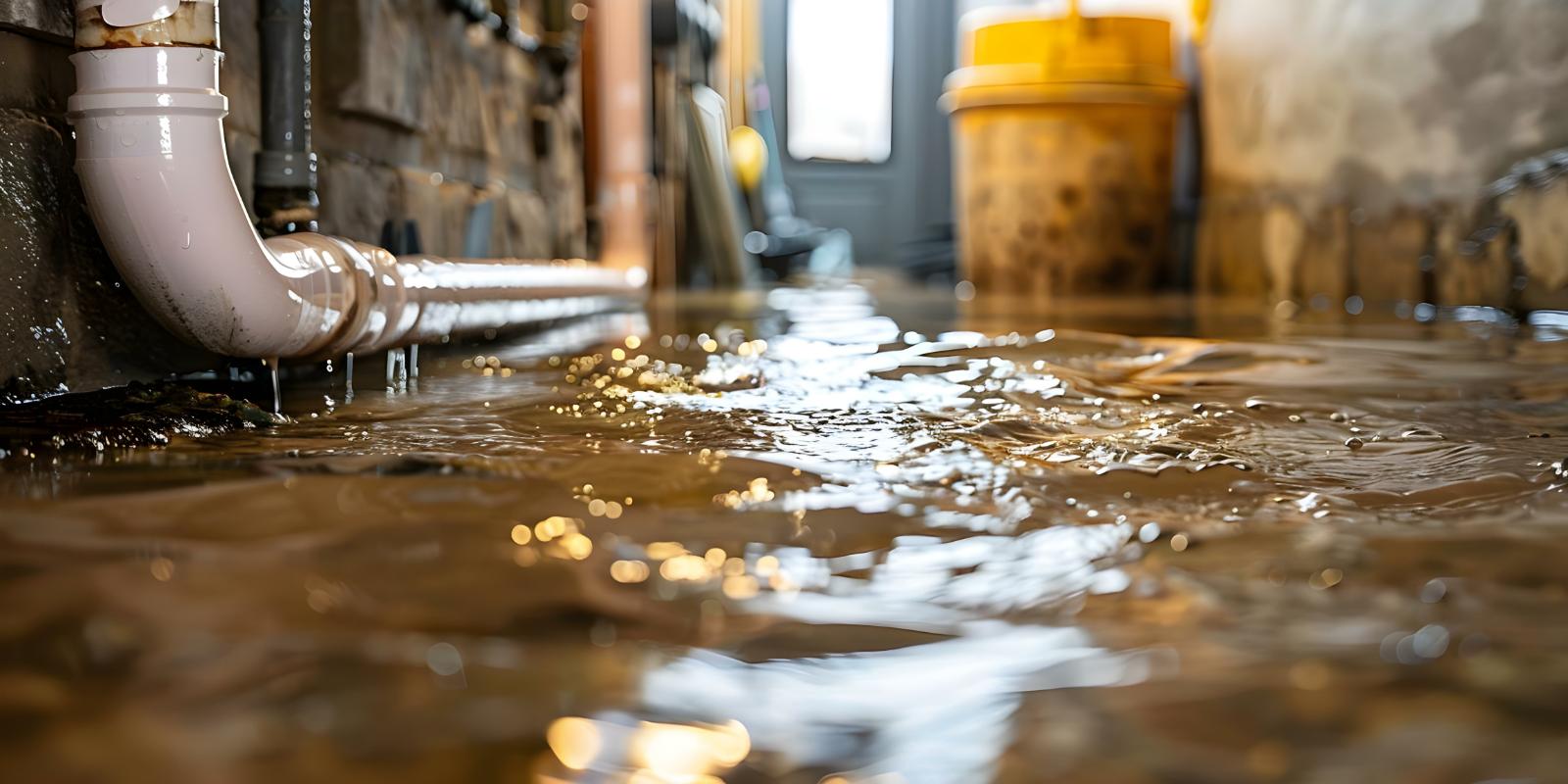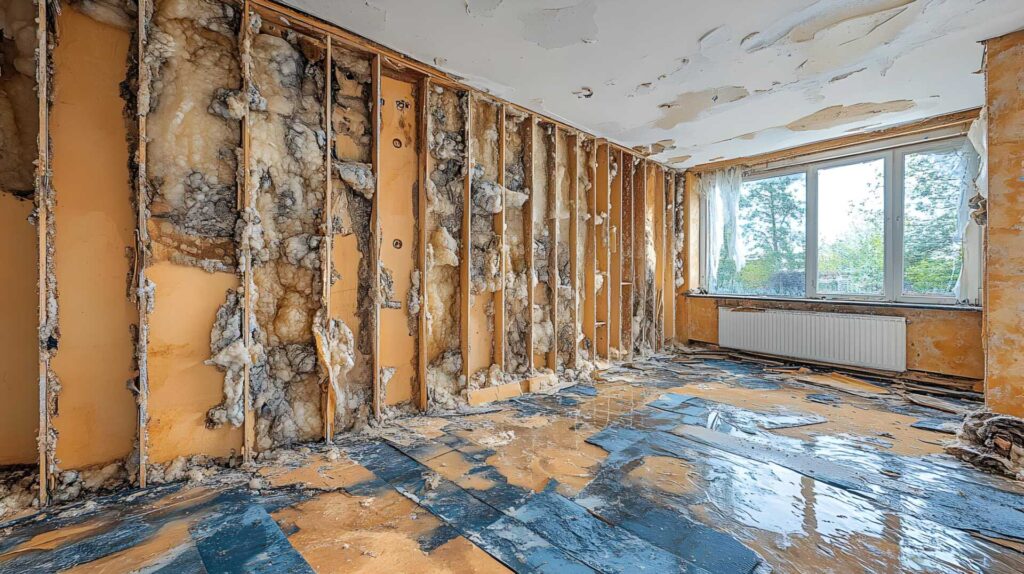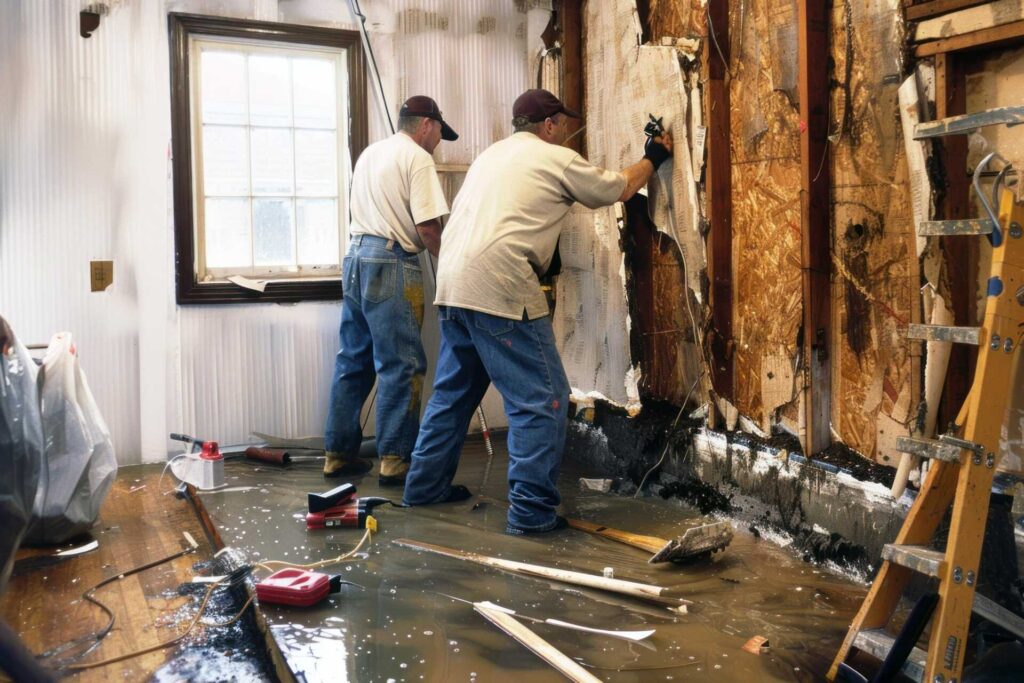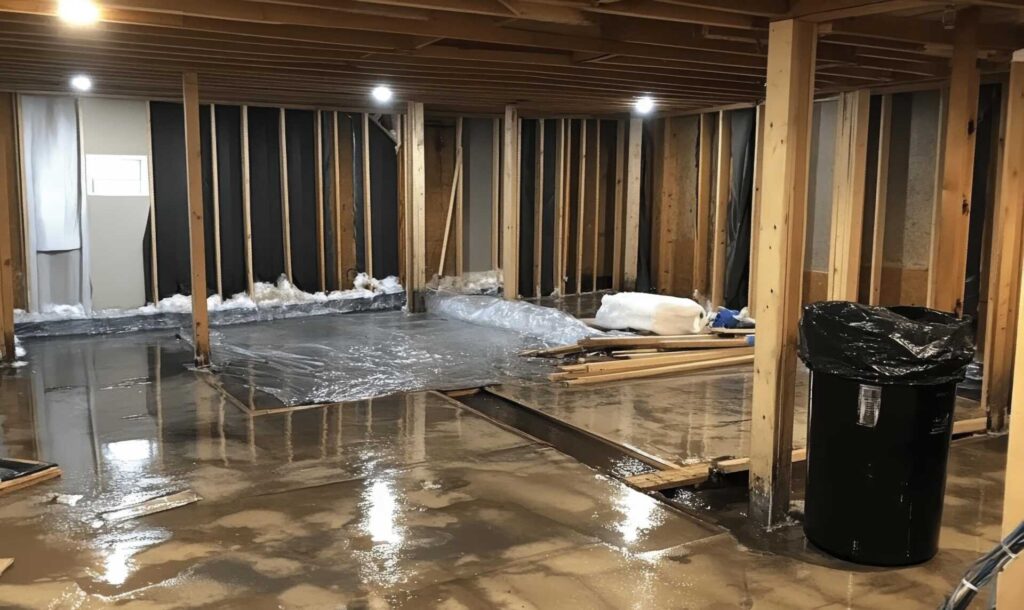Contents
Ensuring effective basement drainage is paramount to safeguarding your home from potential flooding disasters. Water can quickly accumulate around your foundation, from heavy rains to melting snow, leading to costly damage and health hazards. By taking proactive steps to manage water flow and moisture levels, you can significantly reduce the risk of basement flooding. So, how can you ensure your basement remains dry and secure during the next storm?
Key Takeaways
- Proper grading diverts water away from the foundation.
- Install a sump pump in a strategic location.
- Utilize a French drain to prevent water pooling.
- Regular maintenance of drainage systems is essential.
- The professional assessment ensures effective water management.
Importance of Proper Grading
Proper grading of the soil around your home is essential to ensure effective drainage and prevent basement flooding. Soil compaction plays a crucial role in this process. Compacted soil allows water to flow away from the foundation, reducing the risk of water seeping into the basement. Landscaping can aid in maintaining the soil’s integrity, preventing erosion, and maintaining proper grading.
Improper grading can lead to a host of issues, including foundation settlement. When water isn’t directed away from the foundation due to poor grading, it can accumulate around the base of the structure. This water buildup can exert pressure on the foundation walls, leading to cracks and potential settlement problems. Erosion control is vital in ensuring that the soil around your home remains stable and properly graded.
To address grading concerns, start by assessing the slope of the land around your home. Ideally, the ground should slope away from the foundation at a minimum gradient of 5%. This slope allows water to flow away naturally. Regular maintenance of the soil, such as adding topsoil to low areas and regrading as needed, can help maintain proper drainage.
Installing a Sump Pump
You must understand the benefits of a sump pump, the installation process, and key maintenance tips for optimal functionality.
The sump pump plays a crucial role in keeping your basement dry by removing excess water buildup.
To ensure its effectiveness, proper installation, and regular maintenance are essential tasks.
Sump Pump Benefits
Installing a sump pump in your basement offers numerous benefits, such as preventing flooding and maintaining a dry environment. Sump pumps are highly beneficial in terms of energy efficiency, as they only activate when needed, conserving electricity and reducing overall energy consumption. Additionally, sump pumps contribute to significant cost savings by preventing water damage to your basement, which can lead to expensive repairs and potential loss of valuables.
To better understand the advantages of installing a sump pump, let’s take a look at the following table:
| Sump Pump Benefits – Energy Efficiency | Sump Pump Benefits – Cost Savings |
|---|---|
| Activates only when necessary | Prevents costly water damage |
| Reduces overall energy consumption | Minimizes the risk of repairs |
Installation Process Overview
Begin by assessing the location in your basement where the sump pump will be installed to ensure optimal functionality and efficiency. Look for the lowest spot where water tends to accumulate. This is typically near the perimeter of your basement.
Once you’ve identified the location, dig a hole for the sump pump basin. The basin should be large enough to accommodate the pump and allow space for water to collect.
Next, it’s crucial to connect the sump pump to a proper drainage system. This system will ensure that water is efficiently directed away from your home’s foundation. Consider incorporating waterproofing solutions such as a vapor barrier or sealant to protect the pump and surrounding area from moisture damage.
After installing the sump pump and connecting it to the drainage system, test the pump to ensure it’s working correctly. Regular maintenance, including checking for debris and periodically testing the pump, will help guarantee its effectiveness in preventing basement flooding.
Maintenance Tips for Effectiveness
To maintain the effectiveness of your newly installed sump pump, regular upkeep, and monitoring are necessary to ensure its functionality in preventing basement flooding. Here are four essential maintenance tips:
Check the Sump Pump Regularly:
Inspect the sump pump for any signs of damage or debris buildup. Ensure the float switch moves freely and test the pump by pouring water into the pit.Clean the Sump Pump:
Remove any dirt, stones, or other debris that may clog the pump. Keep the inlet screen clear to prevent blockages.Test the Backup Power:
In case of a power outage, make sure the backup power source (if applicable) is in working condition. Test it periodically to avoid surprises during emergencies.Monitor Surrounding Conditions:
Maintain proper ventilation and consider using a dehumidifier to prevent excess moisture buildup. Implement landscaping solutions like downspout extensions to direct water away from the foundation.
Exterior Drainage Solutions
You must ensure proper grading around your home to direct water away from the foundation.
Installing a French drain can help prevent water from pooling next to your basement walls.
Sump pump placement should be strategic to pump out excess water from the exterior drainage system effectively.
Proper Grading for Drainage
Proper grading around your home is crucial for effective exterior drainage solutions to prevent basement flooding. Ensuring that the ground slopes away from your foundation helps direct water away from your basement walls, reducing the risk of water seepage.
To achieve optimal drainage grading, consider the following:
Landscaping solutions: Implementing strategic landscaping features like swales, berms, or rain gardens can help manage excess water around your home.
DIY grading: You can attempt to adjust the grading yourself by adding soil to create the desired slope away from your foundation. However, it’s essential to ensure proper compaction to prevent future settling issues.
Professional assessment: Hiring a professional to assess your grading can provide expert insights into any existing issues and the most effective solutions for proper drainage.
Drainage landscaping: Incorporating plants with deep root systems can help absorb excess water and prevent soil erosion, contributing to better overall drainage.
French Drain Installation
Achieving effective exterior drainage solutions, such as French drain installation, can further enhance your basement flood prevention efforts by efficiently managing water flow away from your home’s foundation.
French drains are a popular choice due to their effectiveness in directing water away from vulnerable areas. The design of the drainage system is crucial to ensure optimal performance. Proper placement and slope of the French drain are essential for effective water diversion. By strategically placing the drain around the perimeter of your home, you can prevent water accumulation that may lead to moisture seepage and potential water damage.
When considering French drain installation, it’s important to focus on water damage prevention. The design should account for the volume of water expected during heavy rainfall to prevent overflow or backup.
Installing a reliable French drain system is a proactive approach to safeguarding your basement from flooding. With proper drainage system design, you can significantly reduce the risk of water damage and maintain a dry and secure basement environment.
Sump Pump Placement
Effective sump pump placement plays a critical role in optimizing exterior drainage solutions to prevent basement flooding. When considering the placement of your sump pump, there are key factors to keep in mind:
Distance from the Foundation: Ensure the sump pump is placed at a sufficient distance from the foundation to prevent water from seeping back into the basement.
Gravity Drainage: Position the sump pump in a location where gravity can assist in draining water away from the house effectively.
Accessibility for Maintenance: Place the sump pump in an area that’s easily accessible for regular maintenance and inspections to ensure its proper functioning.
Alarm and Monitoring Integration: Integrate sump pump alarm and monitoring solutions to receive alerts in case of pump failure or high water levels, enabling quick action to prevent flooding incidents.
Strategic sump pump placement, coupled with regular maintenance and monitoring, is essential for a robust exterior drainage system that safeguards your basement against potential flooding.
Interior Waterproofing Systems
To effectively manage water infiltration in basements, interior waterproofing systems can be installed to create a barrier against moisture penetration. These systems are crucial components in preventing water damage and mold growth within your basement. When considering interior waterproofing, focus on incorporating drainage solutions and waterproofing methods to ensure a comprehensive approach.
Interior drainage solutions are essential in directing water away from your basement walls and foundation. Installing interior drainage systems like French drains or interior weeping tile systems helps to collect water that seeps through the walls and redirects it to a sump pump for removal. By effectively managing the water inside your basement, you can prevent it from causing structural damage and flooding.
In addition to drainage solutions, employing waterproofing methods such as applying waterproof coatings or sealants to the interior walls can provide an extra layer of protection against moisture infiltration. These methods create a barrier that repels water and moisture, safeguarding your basement from leaks and dampness.
Maintenance of Gutters and Downspouts
Maintaining gutters and downspouts plays a critical role in managing water around your home and preventing basement flooding. Proper upkeep of these components is essential to ensure water is effectively diverted away from your foundation.
Here are four key steps to help you safeguard your basement from potential water damage:
Regular Gutter Cleaning: It’s vital to clean your gutters at least twice a year, ideally in the spring and fall. Leaves, twigs, and debris can accumulate, blocking the flow of water. Clogged gutters can lead to overflow, causing water to seep down the foundation walls and into your basement.
Inspect and Repair: Regularly inspect your gutters for any signs of damage, such as cracks, holes, or sagging. Ensure that the gutters are securely attached to your home. Addressing any issues promptly can prevent water from leaking into your basement.
Install Downspout Extensions: Downspout extensions direct water further away from your home’s foundation. Make sure they extend at least 5-10 feet away to prevent water from pooling close to the basement walls. This simple addition can significantly reduce the risk of basement flooding.
Maintain Vegetation: Trim trees and bushes near your gutters and downspouts. Overhanging branches can deposit debris into the gutters, while roots from plants close to the foundation can cause damage to the drainage system. Regular maintenance of vegetation can help preserve the effectiveness of your gutter system.
French Drain Installation
When considering basement drainage solutions, installing a French drain is a strategic measure to manage groundwater and prevent flooding effectively. A French drain is a trench filled with gravel or rock containing a perforated pipe that redirects surface water and groundwater away from your foundation. The installation involves digging a sloped trench and placing the pipe with the perforations facing downwards to facilitate water flow. To enhance the efficiency of the drainage system, consider the following components:
| Component | Description | Purpose |
|---|---|---|
| Perforated Pipe | Allows water to enter and be redirected away from the foundation. | Key element in water management. |
| Gravel or Rock Fill | Surrounds the pipe, providing a path for water to flow. | Facilitates proper drainage. |
| Filter Fabric | Placed over the gravel to prevent clogging. | Ensures the system functions optimally. |
| Discharge Outlet | Directs water away from the foundation. | Essential for preventing flooding. |
Proper installation of a French drain can significantly improve your basement’s water management, protecting it from potential flooding issues. By effectively diverting water away from the foundation, a French drain serves as a vital component of a comprehensive basement drainage system.
Basement Waterproofing Paint
Applying basement waterproofing paint serves as a protective barrier against moisture infiltration, safeguarding your basement from potential water damage. Waterproofing methods like using basement waterproofing paint are crucial in preventing basement seepage.
Here are four essential points to consider when using basement waterproofing paint:
Preparation is Key: Before applying the waterproofing paint, ensure the basement walls are clean, dry, and free of any existing moisture or mold. Properly fill any cracks or gaps to create a smooth surface for the paint to adhere to effectively.
Choose the Right Product: Select a high-quality waterproofing paint specifically designed for basement walls. Consider factors like breathability, flexibility, and resistance to water pressure when making your choice.
Application Technique: Follow the manufacturer’s instructions for the application of the waterproofing paint. Typically, it involves using a brush, roller, or sprayer to achieve even coverage. Apply multiple coats as necessary for optimal protection.
Regular Maintenance: Keep an eye on the condition of the waterproofing paint over time. Touch up any areas where the paint may have worn off or been damaged to ensure continuous protection against basement seepage.
Professional Inspection and Maintenance
To ensure the long-term effectiveness of your basement waterproofing efforts, a professional inspection and maintenance schedule should be implemented to monitor and address any potential issues promptly.
While DIY inspection techniques can be beneficial for routine checks, having a professional assess your basement drainage system annually is crucial in detecting hidden problems early on.
Common drainage issues that may arise include clogged or damaged gutters and downspouts, which can lead to water accumulation around the foundation. Improper grading around the perimeter of your home can also cause water to pool near the basement walls, increasing the risk of seepage.
A professional inspection will identify these issues and recommend appropriate solutions.
Additionally, sump pump malfunctions, such as a stuck float switch or power failures, can render your basement vulnerable to flooding. Regular maintenance by a professional can ensure that your sump pump is in optimal working condition when you need it most.
Review
As you navigate the labyrinth of basement drainage solutions, remember that each component is like a puzzle piece fitting together to create a watertight fortress.
Just as a skilled architect meticulously plans each detail of a grand cathedral, you must approach your basement drainage system with precision and care.
By ensuring proper grading, installing sump pumps, maintaining gutters, and implementing waterproofing measures, you can fortify your home against the turbulent waters of potential flooding.




